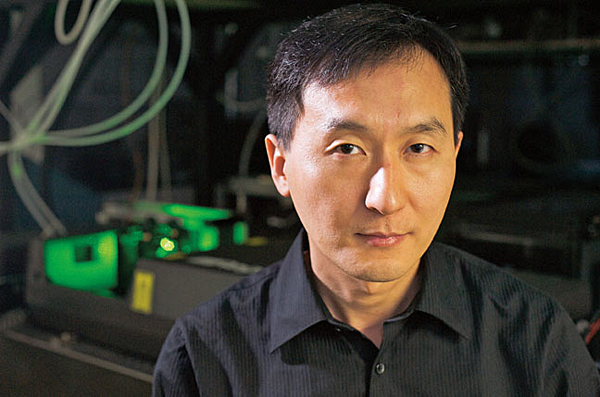In Review
 EFFICIENCY EXPERT: Chunlei Guo, an associate professor of optics, is exploring the use of lasers to improve the efficiency of incandescent lightbulbs (Photo: Richard Baker).
EFFICIENCY EXPERT: Chunlei Guo, an associate professor of optics, is exploring the use of lasers to improve the efficiency of incandescent lightbulbs (Photo: Richard Baker).Optical scientist Chunlei Guo hovers over an elaborate array of lenses and mirrors that glow green with intense laser light. Faces hidden behind large, dark goggles, he and his research assistant, Anatoliy Vorobyev, make a last few adjustments before doing something that seems to undermine the very idea of energy efficiency: Making a light bulb more efficient by blasting it with a laser as powerful as the entire North American electrical grid.
Fortunately, Gou’s laser fires for only a femtosecond—a million, billionth of a second—and uses so little energy that it could be powered by a simple wall outlet. After its treatment by the laser, the bulb might use half as much electricity as before, while remaining far cheaper and radiating a more pleasant light than a fluorescent bulb can.
“We’ve been experimenting with the way ultrafast lasers change metals, and we wondered what would happen if we trained the laser on a filament,” says Guo, an associate professor of optics. “We fired the laser beam right through the glass of the bulb and altered a small area on the filament. When we lit the bulb, we could actually see this one patch was clearly brighter than the rest of the filament, but there was no change in the bulb’s energy usage.”
Gou’s laser process creates a unique array of nano- and micro-scale structures on the surface of a regular tungsten filament—the tiny wire inside a lightbulb—and those structures make the tungsten become far more effective at radiating light. Guo and Vorobyev, who published their findings in the journal Physical Review Letters, report that the key to creating the super-filament is an ultrabrief, ultraintense beam of light—the femtosecond laser pulse. To grasp the speed of the pulse, consider that a femtosecond is to a second what a second is to about 32 million years.
In 2006, Guo and Vorobyev used a similar laser process to turn any metal pitch black. The surface structures created on the metal were incredibly effective at capturing incoming radiation, such as light.
“There is a very interesting ‘take more, give more’ law in nature governing the amount of light going in and coming out of a material,” says Guo. Since the black metal was extremely good at absorbing light, he and Vorobyev set out to study the reverse process, postulating that the blackened filament would radiate light more effectively as well.
“We knew it should work in theory,” says Guo, “but we were still surprised when we turned up the power on this bulb and saw just how much brighter the processed spot was.”
In addition to increasing the brightness of a bulb, Guo’s process can also be used to tune the color of the light. In 2008, his team used a similar process to change the color of nearly any metal to blue, golden, and gray, in addition to the black already achieved. Guo and Vorobyev used their knowledge of how to control the size and shape of the nanostructures—and thus what colors of light those structures absorb and radiate—to change the amount of each wavelength of light the tungsten filament radiates. Though Guo cannot yet make a simple bulb shine pure blue, for instance, he can change the overall radiated spectrum so that the tungsten, which normally radiates a yellowish light, could radiate a more purely white light.
Guo’s team has also been able to make a filament radiate partially polarized light, which until now has been impossible to do without special filters that reduce the bulb’s efficiency. By creating nanostructures in tight, parallel rows, some light that emits from the filament becomes polarized.
The team is working to discover what other aspects of a common lightbulb they might be able to control. And because the femtosecond laser can be powered by a simple wall outlet, eventually implementing the process to augment regular lightbulbs may be relatively simple.
Jonathan Sherwood is a senior science writer in University Communications.
